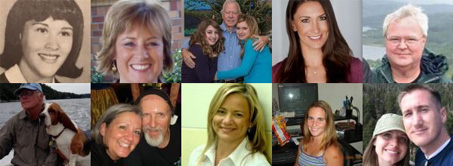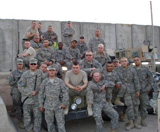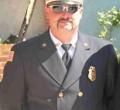Steelton-highspire High School Alumni
Steelton, Pennsylvania (PA)
Alumni Stories
To view the rest of your Steelton-highspire High School Classmates you must first
REGISTER or LOG IN.
REGISTER or LOG IN.
William A "Bill" Beck
Class of 1962
Bill Beck: A Cavalryman at the Ia Drang Valley
By Robert F. Dorr in Land Forces under Featured, History with 2 comments
When the Hueys took them into a clearing in the Ia Drang Valley, the men had no idea they were heading into a fight.
They were American air cavalrymen, trained in a new kind of warfare in which the helicopter gave them mobility on the battlefield. The cavalrymen were calm and confident, far better prepared than the draftees who would be inserted willy-nilly into South Vietnam in months to come. They’d trained as a team pioneering air assault before coming to Vietnam. That day, 450 of them were deposited in the tall grass at Landing Zone X-Ray, named for the final letter in the phonetic alphabet.
On the slopes around the forested Ia Drang, far from cities, rail lines, or highways, two regiments totaling 2,000 seasoned North Vietnamese regulars, or NVA, were ready.
The Hueys began landing at X-Ray at 10:48 a.m. on a bright, sunny Nov. 14, 1965. By the end of the day, 16 UH-1D helicopters made four troop lifts before the landing zone became violent and had to be closed. The outfit was the 1/7th Cavalry, a battalion in the regiment that Gen. George Armstrong Custer had commanded during the Indian Wars.
One of the cavalrymen was an assistant machine gunner, 22-year-old Pvt. William A. “Bill†Beck, of Steelton, Pa. He may have been typical of the citizen-soldier of 1965. He had few expectations beyond getting today’s work done and finding his way back to chow and a shower.
“When I was growing up in Steelton, I never even owned a BB gun,†Beck said. “But I had an excellent mentor in Spec. 4 Russell Adams, the machine gunner. We alternated carrying the gun and hauling ammo boxes. I was six-foot-two and Russ was a small kid, about five-six, but he loved that machine gun and he was tough as nails.â€
Hueys land infantrymen in the Ia Drang Valley. Photo courtesy of U.S. Army Center of Military History.
Lt. Col. Harold G. “Hal†Moore commanded the “first of the seventh.†Assistant machine gunner Beck was a member of Moore’s A Company, led by Capt. Ramon A. “Tony†Nadal. Within the company, Beck belonged to a platoon led by 1st Lt. Robert E. Taft, who stepped off a Huey at Landing Zone X-Ray in the middle of the final day of his life.
“It started routinely. I got off the ship and stood there. I opened a can of C-Rations. Then, Taft, our platoon leader, got word on the radio to turn around and head towards a creek bed. That was when they opened up on us.â€
“We were outnumbered 10 to 1. I followed Taft. The lieutenant got hit. Then [Spec. 4] Jerry Kirsch was hit by automatic weapons fire.†Kirsch survived, but Beck came upon another soldier who was already dead and saw still another take wounds.
To his right, Beck watched Spec. 4 Bob Hazen attempting to give first aid to Taft. North Vietnamese bullets smashed into the radio on Hazen’s back. Hazen’s efforts could not save the lieutenant.
Beck and Adams were now anchoring their company’s left flank. A green-clad North Vietnamese appeared in front of the two men. Adams got off a burst of gunfire that killed the foe. Another NVA threw a concussion grenade. Beck recalled, “It exploded directly in front of me. If it had been a shrapnel grenade, it would have killed me.
“The rest of our platoon was in the jungle and we were on flat ground on the flank. We fought there, on and off, for an hour.
“I went back near the LZ to get some ammo. On the way back, I came across Lt. Raul Taboada and gave him first aid.†Taboada was badly wounded, but survived.
“While returning to Russ Adams I encountered two NVA. I dropped my ammo box and used my .45 [automatic pistol] to fire at two NVA who popped up near me. I apparently hit both of them.
Medal of Honor recipient Bruce P. Crandall's UH-1 Huey dispatches infantry while under fire during combat operations in the Ia Drang Valley, Vietnam, November 1965. U.S. Army photo.
“I got back to Russ just as an NVA bullet hit him in the head. It was a hideous wound.â€
Virtually every American Beck had seen since arriving at LZ X-Ray was now dead or wounded, except for a medic named Nall who appeared to help Adams.
Beck took over the M60 machine gun.
“Russ was laying there with his head open. That was the most afraid I ever was in my life. Everything I’d seen up to then was my guys wounded and killed. The only people left were me and [medic] Nall and I figured, we’re next. The fear is ice cold and it numbs the hell out of you but you know you have to act.â€
For hours that must have seemed an eternity, Beck operated the machine gun while NVA charged him from a tree line 100 yards away. “There was a lot of noise and helicopters and some Air Force planes firing rockets nearby. Guys were screaming.â€
For almost an hour, significant help came from an Air Force A-1E Skyraider that made repeated firing passes on the NVA. Then, the A-1E was hit, possibly by shrapnel from its own ordnance. It passed in front of Beck gushing flames. The aircraft piled into a clump of trees, killing pilot Capt. Paul T. McClellan, Jr.
After hours of fighting, Beck’s platoon, company, and battalion still held against the North Vietnamese.
Over the next two days, Beck was caught up in close-quarters fighting with NVA. More Americans were killed near him. During an assault across the same creek bed, he watched a U.S. soldier ram a bayonet into an NVA trooper’s chest, then take wounds himself.
When the shooting stopped, an American army of draft-era citizen soldiers had battled North Vietnam’s most experienced troops and prevailed.
The LZ X-Ray perimeter on the night of Nov. 14, 1965. Bill Beck's position was at the far left of Company A's position, indicated by "A 1/7" on the map. Image courtesy of U.S. Army Center of Military History.
“In later years when we talked about it, the colonel said I’d held the flank of Landing Zone X-ray in exactly the way Chamberlain’s 24th Maine soldiers secured Little Round Top during the Battle of Gettysburg,†said Beck. “North Vietnamese regulars were rushing out of the woods, pouring right into us, and they had just one purpose, to overrun us and inflict a battalion-sized defeat on the United States Army.
“The fighting lasted all night. We used everything – rifles, grenades, bayonets – doing some of the fighting in the glow of flares and some of it in pitch darkness. At one point I braced my rifle on the body of a dead NVA and sighted over top of him to shoot at his comrades.
In recent interviews, Beck said he never learned the identity of “Doc†Nall, who helped save Adams. He would like to find Nall.
Beck left the Army as a specialist four. In 1996, after three decades of bureaucratic delay, Beck and Adams were awarded the bronze star with “V†device for valor. Others say Beck should have gotten a higher award.
Today, Beck lives in Camp Hill, Pa. A free-lance artist since 1972, he has been diagnosed with post-traumatic stress disorder but, “day by day, I’m handling it,†with help from his wife of nine years, Jennifer. He sees fellow veteran Russ Adams occasionally.
Top photo:
Spec. 4 Bill Beck in 1965. Robert F. Dorr Collection.
By Robert F. Dorr in Land Forces under Featured, History with 2 comments
When the Hueys took them into a clearing in the Ia Drang Valley, the men had no idea they were heading into a fight.
They were American air cavalrymen, trained in a new kind of warfare in which the helicopter gave them mobility on the battlefield. The cavalrymen were calm and confident, far better prepared than the draftees who would be inserted willy-nilly into South Vietnam in months to come. They’d trained as a team pioneering air assault before coming to Vietnam. That day, 450 of them were deposited in the tall grass at Landing Zone X-Ray, named for the final letter in the phonetic alphabet.
On the slopes around the forested Ia Drang, far from cities, rail lines, or highways, two regiments totaling 2,000 seasoned North Vietnamese regulars, or NVA, were ready.
The Hueys began landing at X-Ray at 10:48 a.m. on a bright, sunny Nov. 14, 1965. By the end of the day, 16 UH-1D helicopters made four troop lifts before the landing zone became violent and had to be closed. The outfit was the 1/7th Cavalry, a battalion in the regiment that Gen. George Armstrong Custer had commanded during the Indian Wars.
One of the cavalrymen was an assistant machine gunner, 22-year-old Pvt. William A. “Bill†Beck, of Steelton, Pa. He may have been typical of the citizen-soldier of 1965. He had few expectations beyond getting today’s work done and finding his way back to chow and a shower.
“When I was growing up in Steelton, I never even owned a BB gun,†Beck said. “But I had an excellent mentor in Spec. 4 Russell Adams, the machine gunner. We alternated carrying the gun and hauling ammo boxes. I was six-foot-two and Russ was a small kid, about five-six, but he loved that machine gun and he was tough as nails.â€
Hueys land infantrymen in the Ia Drang Valley. Photo courtesy of U.S. Army Center of Military History.
Lt. Col. Harold G. “Hal†Moore commanded the “first of the seventh.†Assistant machine gunner Beck was a member of Moore’s A Company, led by Capt. Ramon A. “Tony†Nadal. Within the company, Beck belonged to a platoon led by 1st Lt. Robert E. Taft, who stepped off a Huey at Landing Zone X-Ray in the middle of the final day of his life.
“It started routinely. I got off the ship and stood there. I opened a can of C-Rations. Then, Taft, our platoon leader, got word on the radio to turn around and head towards a creek bed. That was when they opened up on us.â€
“We were outnumbered 10 to 1. I followed Taft. The lieutenant got hit. Then [Spec. 4] Jerry Kirsch was hit by automatic weapons fire.†Kirsch survived, but Beck came upon another soldier who was already dead and saw still another take wounds.
To his right, Beck watched Spec. 4 Bob Hazen attempting to give first aid to Taft. North Vietnamese bullets smashed into the radio on Hazen’s back. Hazen’s efforts could not save the lieutenant.
Beck and Adams were now anchoring their company’s left flank. A green-clad North Vietnamese appeared in front of the two men. Adams got off a burst of gunfire that killed the foe. Another NVA threw a concussion grenade. Beck recalled, “It exploded directly in front of me. If it had been a shrapnel grenade, it would have killed me.
“The rest of our platoon was in the jungle and we were on flat ground on the flank. We fought there, on and off, for an hour.
“I went back near the LZ to get some ammo. On the way back, I came across Lt. Raul Taboada and gave him first aid.†Taboada was badly wounded, but survived.
“While returning to Russ Adams I encountered two NVA. I dropped my ammo box and used my .45 [automatic pistol] to fire at two NVA who popped up near me. I apparently hit both of them.
Medal of Honor recipient Bruce P. Crandall's UH-1 Huey dispatches infantry while under fire during combat operations in the Ia Drang Valley, Vietnam, November 1965. U.S. Army photo.
“I got back to Russ just as an NVA bullet hit him in the head. It was a hideous wound.â€
Virtually every American Beck had seen since arriving at LZ X-Ray was now dead or wounded, except for a medic named Nall who appeared to help Adams.
Beck took over the M60 machine gun.
“Russ was laying there with his head open. That was the most afraid I ever was in my life. Everything I’d seen up to then was my guys wounded and killed. The only people left were me and [medic] Nall and I figured, we’re next. The fear is ice cold and it numbs the hell out of you but you know you have to act.â€
For hours that must have seemed an eternity, Beck operated the machine gun while NVA charged him from a tree line 100 yards away. “There was a lot of noise and helicopters and some Air Force planes firing rockets nearby. Guys were screaming.â€
For almost an hour, significant help came from an Air Force A-1E Skyraider that made repeated firing passes on the NVA. Then, the A-1E was hit, possibly by shrapnel from its own ordnance. It passed in front of Beck gushing flames. The aircraft piled into a clump of trees, killing pilot Capt. Paul T. McClellan, Jr.
After hours of fighting, Beck’s platoon, company, and battalion still held against the North Vietnamese.
Over the next two days, Beck was caught up in close-quarters fighting with NVA. More Americans were killed near him. During an assault across the same creek bed, he watched a U.S. soldier ram a bayonet into an NVA trooper’s chest, then take wounds himself.
When the shooting stopped, an American army of draft-era citizen soldiers had battled North Vietnam’s most experienced troops and prevailed.
The LZ X-Ray perimeter on the night of Nov. 14, 1965. Bill Beck's position was at the far left of Company A's position, indicated by "A 1/7" on the map. Image courtesy of U.S. Army Center of Military History.
“In later years when we talked about it, the colonel said I’d held the flank of Landing Zone X-ray in exactly the way Chamberlain’s 24th Maine soldiers secured Little Round Top during the Battle of Gettysburg,†said Beck. “North Vietnamese regulars were rushing out of the woods, pouring right into us, and they had just one purpose, to overrun us and inflict a battalion-sized defeat on the United States Army.
“The fighting lasted all night. We used everything – rifles, grenades, bayonets – doing some of the fighting in the glow of flares and some of it in pitch darkness. At one point I braced my rifle on the body of a dead NVA and sighted over top of him to shoot at his comrades.
In recent interviews, Beck said he never learned the identity of “Doc†Nall, who helped save Adams. He would like to find Nall.
Beck left the Army as a specialist four. In 1996, after three decades of bureaucratic delay, Beck and Adams were awarded the bronze star with “V†device for valor. Others say Beck should have gotten a higher award.
Today, Beck lives in Camp Hill, Pa. A free-lance artist since 1972, he has been diagnosed with post-traumatic stress disorder but, “day by day, I’m handling it,†with help from his wife of nine years, Jennifer. He sees fellow veteran Russ Adams occasionally.
Top photo:
Spec. 4 Bill Beck in 1965. Robert F. Dorr Collection.

Recent Members
| Deasia Durham | 2019 |
| Donna Swartz | 1980 |
| Homer P Kuba Homer P Kuba | 1974 |
| Javius Dent | 2024 |
| Mary Bender | 1965 |
| Patricia Neibich | 1970 |
| Sylvia Bauer Bauer | 1980 |
| Tami Ta | 2006 |
Military Alumni
Honoring Our Heroes
This area is dedicated to our alumni that have served or are serving in our armed forces!
Lost Class Rings
Have you lost your Steelton-highspire High School class ring? Have you found someone's class ring? Visit our Steamrollers lost class ring page to search for your class ring or post information about a found ring.
Do you have a fun holiday story or a great family tradition? Share them with our fellow Steelton-highspire High School alumni! Submit your own stories, achievements and photos in our Alumni Stories section. Read other classmate’s stories and see what they have been up to over the years.
Happy Holidays!
Happy Holidays!

